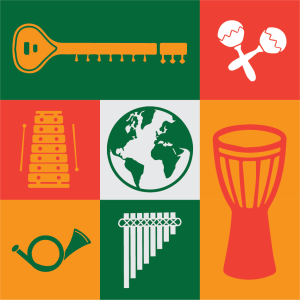Persian Music
Dr Howard Spring and Dr Ryan Bruce

Overview
Two primary modal systems of traditional music in West Asia are the maqam (spanning most of the geographic region and across North Africa), and the Persian radif from Iran. Although related in terms of oral transmission, tonal quality, some performance practices, and with some shared instruments and vocal performance practices, the radif is distinguished as a repertoire of malleable short pieces (gushe) within its own system of modes (dastgah). The radif is historically more recent than maqam and has its own important rhythms and metrical cycles for melodic instruments and percussion.
Like other art-music traditions, the radif presents a sophisticated organization of musical materials as a theory, resources for composition, interpretation, and improvisation. It also contains expectations for performance, and is played by soloists, ensembles, and has close associations with Persian poetry. Based on the dastgah, harmony is disregarded in favour of exploring the vast possibilities of creating melody.
Musician
Mohammad Reza Yazdanpanah
Mohammad Reza Yazdanpanah is an Iranian musician who is an improviser, composer, performer, and multi-instrumentalist. He served as a faculty member at the University of Guilan where he taught classical repertoire, radif, and improvisation on tar and setar. He is equally comfortable playing a range of styles based on folkloric, traditional, and classical Persian music with recordings, and publications on teaching the radif for tar.
Reza moved to Canada in 2019 for graduate studies at the International Institute for Critical Studies in Improvisation at the University of Guelph, and continues to work as a performer and educator in the region.
Terminology
An understanding of the following terms would be helpful before proceeding with the Video Content.
- Tar
- Setar
- Tombak
- Daf
- Radif
- Gushe
- Dastgah
- Pishdaramad
- Daramad
- Chahar Mezrab
- Avaz
- Tasnif
- Reng
Video Content
Reza introduces Persian classical music by explaining how he came to hear, love, and learn the tradition in Iran. He uses the fretted plucked-stringed chordophones of tar and setar to demonstrate and discuss the radif with examples of its dastgah, gushes, concepts for their performance, and ways they are organized in the system. The topic of composition and improvisation is developed as it relates to performing the radif, playing in free rhythm, and with rhythm and metre. Typical concerts are explained and demonstrated, namely the succession of pieces, their tempos, rhythm and metre, composed and improvised pieces, and instrumental and vocal genres. The video concludes with examples of singing, the tombak (goblet drum), and the daf—a percussion instrument in Kurdish folk music and later adopted by the Persian classical tradition.
Video Time Cues
- 0:07 Self-introduction and learning to play
- 2:03 Improvisation on dastgah Mahur on setar (daramad)
- 3:36 Structures: radif, dastgah, avaz, gushe
- 8:45 Learning the instruments, radif, and Western music
- 11:11 Description and demo of the setar
- 14:16 Description of the tar
- 17:57 Tar demonstration: dastgahs Mahur and Rast-Panjgah
- 20:33 Tuning for performance on the tar
- 23:06 Names of dastgahs, gushes/comparing major & Mahur
- 26:00 Gushe yesh/avaz, daramad of Mahur
- 28:35 Composition and improvisation from the radif
- 38:26 Structure of a performance:
- 38:26 Pishdaramad
- 41:19 Instrumental daramad and improvisation
- 43:14 Chahar Mezrab
- 44:01 Avaz (vocal)
- 50:12 Transition to Tasnif
- 52:10 Reng
- 56:00 Changing modes during a performance
- 1:01:53 Microtones in Persian music
- 1:06:26 Rhythmic and metric playing
- 1:10:10 Rhythmic patterns, metre, and singing with tombak
- 1:22:27 Kurdish folk/Persian classical: percussion on daf
Suggested Activities and Assessments
Terms
Create a limited-access wiki of the terms and their definitions listed in the Terminology section above. Students can work individually to create their own “wiki” as text files, or in teams (e.g., through a course website). Students research the meanings, and if relevant, the history of these terms.
Participation
- Counting and clapping practice exercise
Different metrical cycles are demonstrated, for example groupings of 6, 4, 2, and different additive patterns in 7 and 8 (see the Video Time Cues section for the tombak). Follow Reza’s prompts for counting, and continue clapping and counting along to the beat cycles. It is more difficult than it seems. - Quiz: Game show
What section is this?
The instructor plays various parts of a typical performance, such as pishdaramad, instrumental daramad, chahar mezrab, Avaz (vocal), tasnif, and reng. All have specific features related to tempo, rhythm and metre, instruments and voice, among other aspects of melodic treatment and improvisation. Students have to identify the section, and why they came to that decision. - Debate
In separate groups, argue for or against: Persian music is a source for developing individuality among performers in the tradition. The debate aims at thinking of musical features that are the same among musicians, and ways in which performers may articulate their own interpretations of the material (or not).
Research
Compare and contrast traditions of the maqam and Persian radif. Answers will relate to sound, concept, and behaviour, including historical similarities and differences.
